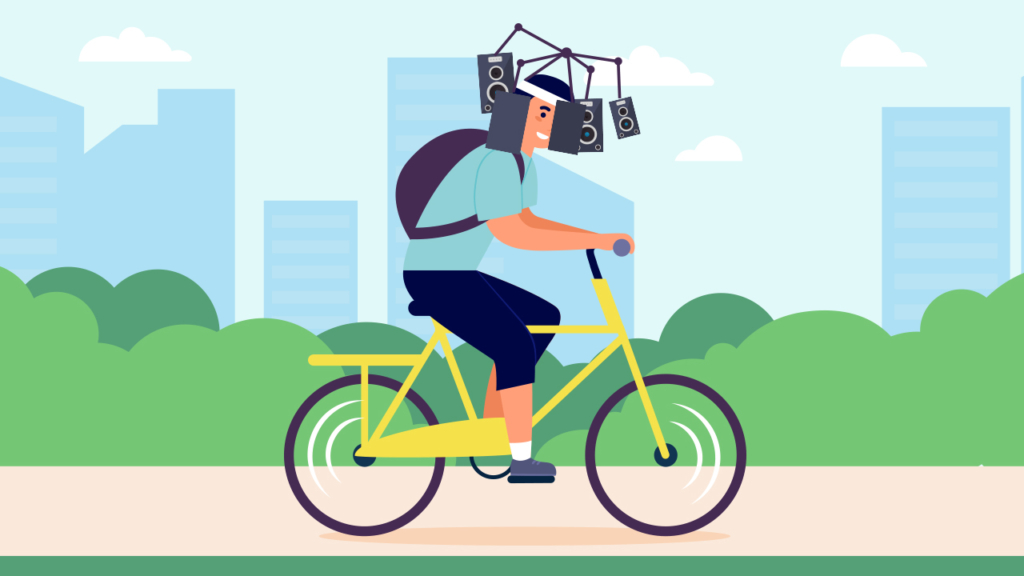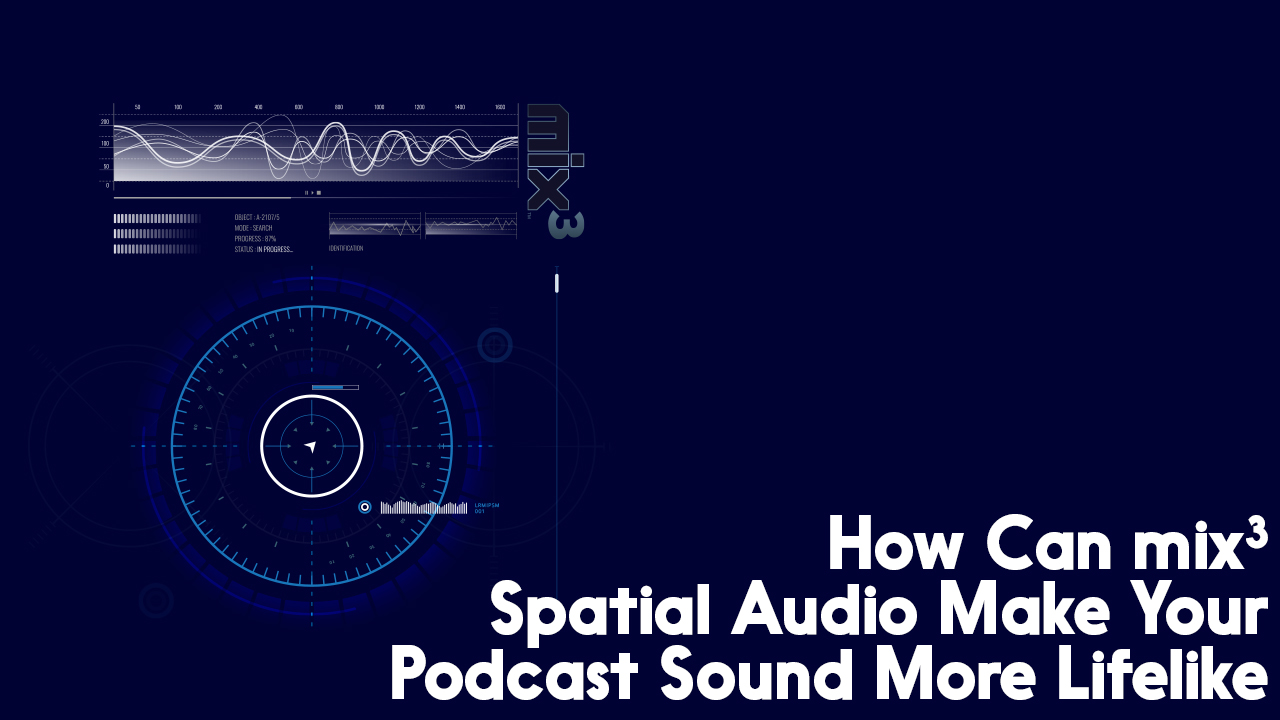Apple’s Spatial Audio: What Does This Mean For Podcasters?
Apple Music recently introduced “spatial audio” to their service. This means they’re using Dolby Atmos to make the listener feel like the music is being played around them, immersing them in the musical experience. The Apple Music Spatial Audio Playlists include music engineered to make the most of this technology. The new mixes sound clear, crisp, and the instruments and vocals feel more distinct. Apple also announced “lossless audio,” meaning that Apple Music plays at up to 24-bit 192kHz. I’ll explain what that means in a bit. On the right speakers or headphones, this makes an exciting music listening experience. But, does Apple’s Spatial Audio matter for podcasters?
Related Article
How Can mix³ Spatial Audio Make Your Podcast Sound More Lifelike
Mix³ can help you edit and produce spatial audio, building intimacy and compelling realism in your podcast. Find out more »
What Does Apple’s Spatial Audio Mean for Listeners?
This has two facets: data and equipment.
What Is “Lossless Audio?”
When you hear the term “lossless”, think of it almost like the master copy of an audio file. It contains all the data of the original recording, and so nothing has been “lost”. A visual metaphor might be an oil painting being the lossless version, and a print of that painting being akin to the files we typically listen to audio, via a streaming service.
In short, a 24-bit 192kHz audio file has more data in it than most audio tracks you hear on a streaming service.. Matthew explained sample rates for podcasting in a previous article, and Colin explained bitrate for podcasting as well. Lossless audio sounds more detailed because there’s more data in the audio file. But, it can take longer to download. In a streaming service, this can mean that you need to pay more for faster download speeds.
What Can You Use To Hear This Audio?
As we all know, audio sounds as good as the equipment you play it through. Whatever headphones or earbuds hit the sweet spot of comfort, convenience and quality for you is different for others. Apple’s Spatial Audio uses Dolby Atmos, a sound system originally designed for cinemas, cars, and home theatre systems. For headphone users, the efficacy is unclear. According to James Cridland of Podnews, Apple’s Spatial Audio “will only work on AirPods and Beats headphones with an H1 or W1 chip, which changes as you move your head.” Apple explained the necessary settings and equipment. So… that could make you dizzy.
James Cridland of says, “we don’t get it for podcasting,” and posits that most listeners may not be able to hear the difference. The Verge tested Apple’s AirPods Max, which couldn’t play Apple’s magical audio, even plugged in via a lightning cable.
How Does It Sound?
Does Apple’s spatial audio sound cool? Yeah, pretty much. I tried it using a pair of basic, entry-level AirPods, and with a couple of Wonderboom 2 pairable Bluetooth speakers. Did it sound as though I were surrounded by musicians, with music swirling around me as I moved through a musical space? No. Maybe if I were in a car with 5 surround-sound speakers, the sound might have the intended effect. Or, maybe if I took a parasol and dangled a speaker from the ribs at even intervals, then held it directly over my head, it could have worked.

What Does This Mean for Podcasts?
Like Cridland said, there’s no clear benefit. For podcasts that don’t make use of atmospheric elements, particularly if they’re produced at a lower sample rate and bitrate, they won’t benefit from Apple’s spatial audio. If your podcast consists of two people talking about something, without music, special effects, or background sounds, this isn’t news you can use.
But, podcasts have made use of spatial audio for years. They just didn’t call it that. It’s been called “immersive audio,” “3D audio” and “binaural sound,” meaning that each ear gets a slightly different recording.
For example, Owl Field has specialized in binaural audio fiction since 2015. Binaural audio is recorded with two microphones, placed about 7-8″ apart, the way that typical human ears would pick up sound. The result is audio that’s viscerally affecting and realistic enough to command the audience’s full attention. It can be dizzying. Binaural recording setups used to cost in the thousands and require modified wig stands or dummy heads. But, they’ve become less expensive and more accessible in recent years.
How Can Podcasters Record Binaural Audio?
The Roland CS-10EM looks like a pair of earbuds, provides in-ear monitoring, and pairs with digital recorders. The Zoom H1, for example, can fit in your pocket so you can field-record binaural sound anytime. In my experience, though, you have to think of your head as a mic stand (because it is). Don’t look to your left or right too much as you walk around.
Even without binaural recording, most fiction podcasts benefit from immersive audio. Hostile Worlds, for example, is a highly-produced science documentary podcast that makes the most of multi-layered music, sound effects, and dialogue. Fiction podcasts take more work to make. But, they stimulate more parts of the audience’s brain at the same time.
More listenable? More Engaging.
You don’t have to make a fiction podcast to benefit from highly produced audio. Some brand podcasts succeed by building atmosphere through immersive, multi-layered sound. For example, John Deere’s brand podcast, On Life & Land, uses field recording to build intimacy and authenticity. Their interviews with farmers convey a subtext that farming is beautiful.
Will the audio in the Apple Podcasts app also have “lossless audio?” Recent updates indicate that the Apple Podcasts app needs a lot of help. If lossless audio is part of any improvements, great. Let’s hope podcast producers take full advantage of it.
How Can Podcasters Make The Most of Apple’s Spatial Audio?
It depends. Someone who’s “not all that into podcasts,” but a dedicated Apple user, might be more likely to check out Apple’s Spatial Audio than a podcast, because it sounds more interesting, and it’s the flavor of the month. For dedicated podcast listeners, nothing has really changed.
But, the term “spatial audio” is in the zeitgeist. Podcasters could drop the term “spatial audio” into their SEO, if they make particularly immersive podcasts. This might make their podcasts more discoverable. Video games and live theatre make use of spatial audio already. Apple’s Spatial Audio for music catches up inspired audio creators in other media. It remains to be seen whether or not users want spatial audio badly enough to buy the listening devices that can provide it.


